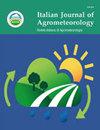基于温度、降雨和相对湿度的人工智能模型在温暖亚湿润环境下每日参考蒸散量预测的评价
IF 0.8
4区 农林科学
Q2 AGRONOMY
Italian Journal of Agrometeorology-Rivista Italiana Di Agrometeorologia
Pub Date : 2022-07-19
DOI:10.36253/ijam-1373
引用次数: 1
摘要
准确估算参考蒸散量对农业管理和水资源工程应用具有重要意义。在本研究中,利用墨西哥温暖亚湿润气候的五个地点的有限天气数据,评估了三种人工智能(AI)模型(即支持向量机(svm)、自适应神经模糊推理系统(ANFIS)和分类增强(CatBoost))估算每日参考蒸散(ET0)的能力和精度。Penman-Monteith FAO-56方程被用作ET0值的参考指标。研究了三种不同的输入组合,即基于温度(最低气温和最高气温)、基于降雨量(最低气温、最高气温和降雨量)和基于相对湿度(最低气温、最高气温和相对湿度)。在所有组合中都使用了地外辐射值。将基于温度的人工智能模型与传统的Hargreaves-Samani (HS)模型进行了比较,该模型通常用于在只有温度记录的情况下估计ET0。采用决定系数(R2)、Nash-Sutcliffe模型效率系数(NSE)、均方根误差(RMSE)和平均绝对误差(MAE)评价各模型的拟合优度。结果表明,在评估的人工智能模型中,SVM模型对ET0的建模效果优于ANFIS和CatBoost。此外,还研究了相对湿度和降雨量对模型性能的影响。分析表明,相对湿度显著提高了模型的精度。结果表明,基于温度的人工智能模型的响应效果优于HS方法。人工智能模型可以替代传统的ET0模型。本文章由计算机程序翻译,如有差异,请以英文原文为准。
Evaluation of artificial intelligence models for daily prediction of reference evapotranspiration using temperature, rainfall and relative humidity in a warm sub-humid environment
Accurate estimation of reference evapotranspiration is essential for agricultural management and water resources engineering applications. In the present study, the ability and precision of three artificial intelligence (AI) models (i.e., Support Vector Machines (SVMs), Adaptive Neuro-Fuzzy Inference System (ANFIS) and Categorical Boosting (CatBoost)) were assessed for estimating daily reference evapotranspiration (ET0) using limited weather data from five locations in a warm sub-humid climate in Mexico. The Penman–Monteith FAO-56 equation was used as a reference target for ET0 values. Three different input combinations were investigated, namely: temperature-based (minimum and maximum air temperature), rainfall-based (minimum air temperature, maximum air temperature and rainfall), and relative humidity-based (minimum air temperature, maximum air temperature and relative humidity). Extraterrestrial radiation values were used in all combinations. The temperature-based AI models were compared with the conventional Hargreaves–Samani (HS) model commonly used to estimate ET0 when only temperature records are available. The goodness of fit for all models was assessed in terms of the coefficient of determination (R2), Nash–Sutcliffe model efficiency coefficient (NSE), root mean square error (RMSE) and mean absolute error (MAE). The results showed that among the AI models evaluated, the SVM models outperformed ANFIS and CatBoost for modeling ET0. Further, the influence of relative humidity and rainfall on the performance of the models was investigated. The analysis indicated that relative humidity significantly improved the accuracy of the models. Finally, the results showed a better response of the temperature-based AI models over the HS method. AI models can be an adequate alternative to conventional models for ET0 modeling.
求助全文
通过发布文献求助,成功后即可免费获取论文全文。
去求助
来源期刊

Italian Journal of Agrometeorology-Rivista Italiana Di Agrometeorologia
AGRONOMY-ENVIRONMENTAL SCIENCES
CiteScore
2.10
自引率
8.30%
发文量
6
期刊介绍:
Among the areas of specific interest of the journal there are: ecophysiology; phenology; plant growth, quality and quantity of production; plant pathology; entomology; welfare conditions of livestocks; soil physics and hydrology; micrometeorology; modeling, simulation and forecasting; remote sensing; territorial planning; geographical information systems and spatialization techniques; instrumentation to measure physical and biological quantities; data validation techniques, agroclimatology; agriculture scientific dissemination; support services for farmers.
 求助内容:
求助内容: 应助结果提醒方式:
应助结果提醒方式:


